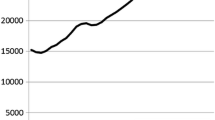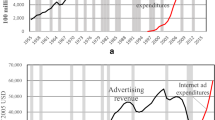Abstract
The purpose of this paper is to investigate how changes in the social environment of print media have affected the history of the Japanese publishing industry in the postwar period. Data on the circulation of books, magazines, and newspapers are analysed on a population basis. The results of these analyses show that per-capita circulation of these media increased almost monotonically until the 1980s, but then began to decrease after peaking in the 1990s. After conducting statistical correlation analyses, we conclude that per-capita circulation was affected by economic trends indicated by the GDP growth rate. Our analyses also show a positive correlation between the pace of change in per-capita book and magazine circulation, and this reciprocal relationship is investigated in detail.









Similar content being viewed by others
References
Shuppan Kagaku Kenkyujo [The Research Institute for Publications] ed. Shuppan Shihyo Nenpo [Yearbook of publishing index]. Tokyo: Zenkoku Shuppan Kyokai Shuppan Kagaku Kenkyujo; 1960–2010.
Shuppan Nyususha Shuppan Nenkan Henshubu ed. Shuppan Nenkan [Yearbook of publishing]. Tokyo: Shuppan Nyususha; 1951–2010.
UNESCO Institute for Statistics. Book production: number of titles by UDC classes. 2010. http://stats.uis.unesco.org/unesco/ReportFolders/ReportFolders.aspx. Accessed 18 August 2010. According to this survey, the top five countries are the U.K., Germany, the U.S., Spain, and Japan. Note, however, that the years of the data vary from 1996 to 1999 depending on the country.
United Nations Population Division. World population prospects: the 2008 revision population database. 2010. http://esa.un.org/unpp/. Accessed 18 August 2010.
UNESCO Institute for Statistics. Newspapers. 2010. http://stats.uis.unesco.org/unesco/ReportFolders/ReportFolders.aspx. Accessed 18 August 2010.
Oda M. Shuppan Gyokai No Kiki To Shakai Kozo [The crisis in the publishing industry and social structure]. Tokyo: Ronsosha; 2007.
Oda M. Shuppansha To Shoten Ha Ikani Shite Kiete Ikuka: Kindai Shuppan Ryutsu Shisutemu No Shuen [In what way will publishers and bookstores perish?: The end of the modern distribution system of publication]. Tokyo: Ronsosha; 2008.
Maeda R. Kami No Hon Ga Horobi Yuru Toki [When paper books perish]. Tokyo: Seidosha; 2009.
Shinbun Terebi Danmatsuma [The death throes of newspapers and television]. Shukan Toyo Keizai. No. 6247, 20 February 2010, p. 34–87.
Soumusho Tokeikyoku [Ministry of Internal Affairs and Communications]. Joho Tsushin Hakusho [The white book of information communications]. Tokyo: Gyosei; 2001–2010.
Dentsu Soken ed. Joho Media Hakusho [The white book of information media]. Tokyo: Daiyamondosha; 1992–2010.
Fujitake A, editor. Zusetsu Nihon No Masu-media [Illustrated mass media in Japan]. 2nd ed. Tokyo: Nippon Hoso Kyokai; 2005.
Kawai R, editor. Shuppan Media Nyumon [Introduction to publishing media]. Tokyo: Nihonhyoronsha; 2006.
Che S. Shuppan Sangyo No Hensen To Shoseki Shuppan Ryutsu [Transitions in the publishing industry and book distribution]. Tokyo: Shuppan Media Paru; 2006.
Kinoshita O. Nihon Shuppan Shijo No Henka: Shuppan Tokei Kara Yomu Shijo No Seijukuka [Changes in Japan’s publishing market: the market recession manifested in publishing statistics]. Shuppan Kenkyu. 2006;37:93–108.
Hoshino W. Nihon Shuppan Sangyo No Kozo Henka: Zasshi Media No Teimei To Dejitaru Gijutsu No Eikyo [Structural changes in the Japanese publishing industry: the downturn in traditional journal media and the ripple effects of digital technology]. Shuppan Kenkyu. 2008;39:5–20.
Greco AN. The book publishing industry. Boston: Allyn & Bacon; 1996.
Daly CP, Henry P, Ryder E. The magazine publishing industry. Boston: Allyn & Bacon; 1996.
Picard RG, Brody JH. The newspaper publishing industry. Boston: Allyn & Bacon; 1996.
Vogel HL. Entertainment industry economics: a guide for financial analysis. 7th ed. Cambridge: Cambridge University Press; 2007.
Nihon Shinbun Kyokai [Japan Newspaper Publishers & Editors Association]. Facts and figures about Japanese newspapers. 2010. http://www.pressnet.or.jp/english/data_e/01circulation.htm. Accessed 17 June 2010.
Soumusho Tokeikyoku [Statistics Bureau, Ministry of Internal Affairs and Communications]. Statistics. 2010. http://www.stat.go.jp/english/data/index.htm. Accessed 17 June 2010.
Monbu Kagakusho [Ministry of Education, Culture, Sports, Science and Technology]. Gakko Kihon Chosa [School basic survey]. 2010. http://www.mext.go.jp/b_menu/toukei/chousa01/kihon/1267995.htm. Accessed 17 June 2010.
Acknowledgments
This research was supported in part by the Japan Society for the Promotion of Science, Grant-in-Aid for Scientific Research, 20300089, 2008–2011.
Author information
Authors and Affiliations
Corresponding author
Rights and permissions
About this article
Cite this article
Umino, B., Kageura, K. & Toda, S. A Sixty Year History and Analysis of the Japanese Publishing Industry: A Statistical Analysis of Circulation. Pub Res Q 26, 272–286 (2010). https://doi.org/10.1007/s12109-010-9183-2
Published:
Issue Date:
DOI: https://doi.org/10.1007/s12109-010-9183-2




